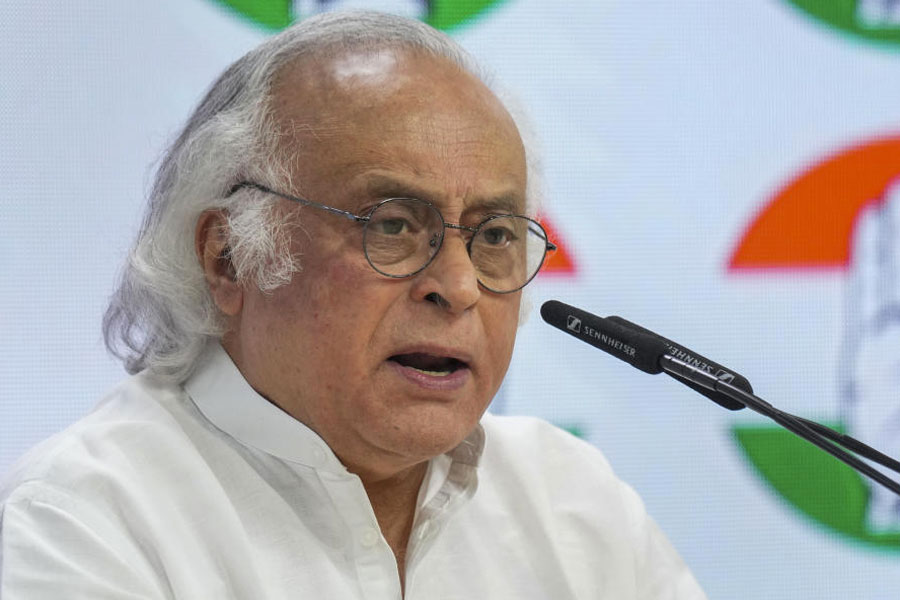|
|
Chandana Hore’s exhibition of recent works at Gallery Akar Prakar (till May 26) begins with a series of arresting watercolours. Painted between 2002 and 2006, these works capture human figures, mostly solitary ones, in various moments of reflection. From the look in their eyes — distant, stricken, out-of-focus, or simply blank — they appear introspective, oblivious to the world around them.
Seen from a distance, these characters (indeed they carry more distinction than just abstract ‘figures’) seem to be framed against patches of colour, dispersed with uneven density. The bodies are translucent, as much capable of emanating light as of absorbing it into themselves. A woman with an umbrella stares askew; a girl looks pensively into a lamp; diseased, ailing bodies gaze vacantly, the burden of noble resignation heavy upon their eyes. Every canvas internalizes a situation without explicating it roundly; rather, the pictures awaken the viewers’ imagination, asking them to venture into their inner histories.
Even in their marked solitariness, Chandana’s characters are memorials to human intimacy. The abstracted stares on their faces appear suspended, waiting to be fixed upon a beloved face. A girl looks searchingly, lovingly into the eyes of a dog, her lips melting into a smile as the creature licks her fingers (picture). Another little girl has fallen asleep with her face turned away from her mother, but secure in the knowledge of the huge canopy of maternal love that protects her.
This desire to be protected by someone, who may be alive or perhaps a figure from the irredeemable past, lies at the heart of Chandana’s vision. Her daring combination of dark and light shades turns her images into receptacles of certain obvious but leaden truths: the inevitable decay of the body, even as the mind refuses to succumb to the vagaries of physical suffering; the experience of happiness as an intensely vertiginous state of being, and the wastefulness of mortality.
As if to confirm this terrifying fragility of existence, the faces dissolve into water. Sometimes the colours of suffering (black, brown, blue and a darker, polluted shade of purple) gather on these faces in shapeless patches. Though the eyes are poignantly expressive, the lips are unspeaking, suffering silently the despotism of the eyes. These eyes always already carry on the work of mourning for the pity of human attachments. They are weary with the realization that there is no intimate friendship, or any other relationship between two people for that matter, without the painful inevitability of one of them dying before the other, perhaps even right before the other one’s eyes.
Apart from this morbid fascination with the persistence of pain and suffering, there is another feature that recurs, with startling results, in Chandana’s work: her playful experiment with colours. She had dedicated her previous major exhibition in Delhi, earlier this year, to her late father, the great Somnath Hore, “who taught [her] to play with pain”. Here too, she is at play with the dark colours of suffering, but, more astonishingly, she uses the colours of joy — yellow, green, red and gentler shades of blue — to draw the most memorable images of pain.
Chandana had, in her unforgettable paintings following her father’s death, discovered the unsettling potential for grief in these smiling colours, primarily red, yellow and lighter shades of green. Some of the canvases from that period have been included in the present show. As in the watercolours, these relatively large oils too depict human beings, alone or in company, with amazing effect. Fierce red, golden yellow, Prussian blue predominate, applied in impasto, thick layers of paint tamed with unruly brushstrokes. The effect of this layering of colours is claustrophobic, but also sensuous: the hands yearn to caress these rugged surfaces, the eyes long to see deep into the far end of the paint.
This thick description of pain (quite literally so) does not remain confined to just these canvases. The images demand the affection of the viewers, a negative capability that would enable them to feel the pain that has been left on the hand that has painted them, unafraid of immense physical exertions.
Strangely, the feelings of being transported into a different order of things, of unshakeable poise in the face of inward unrest, haunt these paintings. In the midst of blood red patches, alongside febrile orange and cloudy blues, a woman sits in a prospect of flowers, even as a flock of birds (drawn in a child-like manner, as a cluster of Vs) takes flight. The figure of the recumbent man, with arms outstretched, appears against a similar setting, but there the flowing red is restrained by an anguished expanse of blue.












